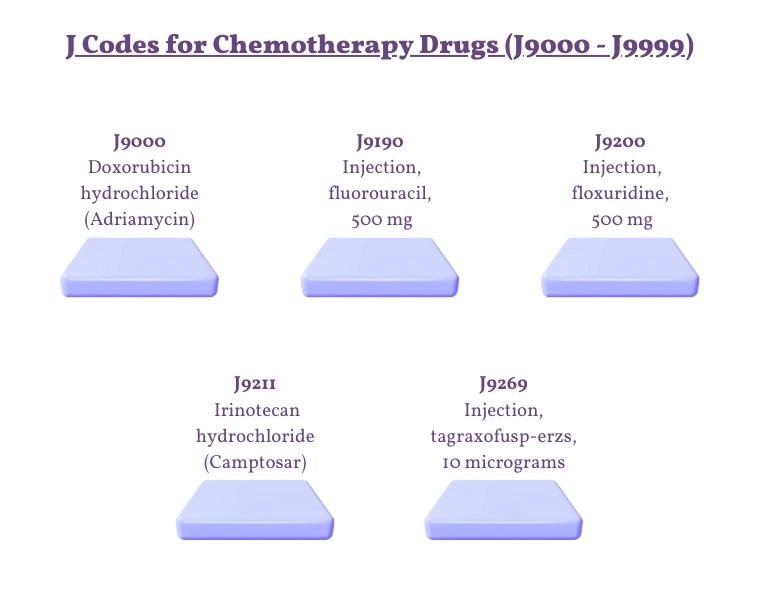Do you ever feel like your medical billing system speaks a different language when it comes to injectable medications? Those mysterious J-codes, a jumble of letters and numbers, hold the key to proper reimbursement, but deciphering them can feel like cracking a code. Well, fret no more, healthcare providers!
This blog guide will provide essential information about J codes, how they work in medical billing, and their importance.
What are J Codes?
In medical billing, "J codes" are part of the Healthcare Common Procedure Coding System (HCPCS) Level II, a set of standardized codes used in the United States to describe specific medical procedures, services, equipment, medications, and supplies. These codes are primarily used by Medicare and managed by the Centers for Medicare and Medicaid Services (CMS). However, they are also widely adopted by other private health insurance companies.
J-codes are used to designate non-oral medications and other medical devices. This includes:
-
Injectable drugs
-
Chemotherapy drugs
-
Inhalation medications
-
Immunosuppressant drugs
-
Some specific orally administered medications that can't be billed using other codes
How J Codes Function In Medical Billing?
J-codes might seem like cryptic symbols, but they actually follow a simple structure. Here's how they work:
Each J-code is a unique combination of one letter followed by four numbers (e.g., J1234). This code identifies the specific medication. J-codes don't directly represent the dosage. Instead, they're paired with "units" to indicate the amount of medication administered. These units can vary depending on the medication (e.g., milligrams, milliliters). When submitting a claim for a J-coded medication, you'll include the J-code itself alongside the number of units used. This allows insurance companies to understand the exact medication and dosage billed.
Example:
Let's say you administer 100mg of a specific antibiotic via injection. You might use J1567 with 1 unit on your claim form. J1567 tells the insurance company the type of antibiotic, and the 1 unit signifies the 100mg dosage (assuming 1 unit = 100mg for this particular medication).
By understanding this structure, you can effectively choose the appropriate J-code and accurately represent the medication and dosage on your claims. This ensures proper reimbursement for your services and keeps your billing process running smoothly.
J-Codes vs. CPT Codes:
While they might seem interchangeable at first glance, each serves a distinct purpose:
J-Codes: These codes, as you already know, represent non-oral medications administered to patients. They identify the specific medication and often work in conjunction with units to indicate the dosage.
CPT Codes: The Current Procedural Terminology (CPT) codes focus on medical services and procedures performed by healthcare providers. These codes describe actions like office visits, surgeries, diagnostic tests, and more. Think of them as the language used to communicate the specific procedures you performed on a patient.
Here's a table summarizing the key differences:
|
Features |
J Codes |
CPT Codes |
|
What They Represent |
Non-Oral Medication |
Medical Procedures and Services |
|
Format |
Letter followed by four number |
Five-digit numeric code |
|
Used With |
Units to indicate dosage |
Used with a modifier for additional details |
|
Example |
J1567(Specific Antibiotic) with 1 unit (100 mg) |
99213 (office visit - Established Patient) |
What are Unlisted J-Codes?
Unlisted J-codes are essentially placeholder codes used when a brand new medication hasn't yet been assigned a specific J-code. The medication exists but falls outside the existing J-code categories. The medication is used in a unique way not typically covered by a standard J-code.
There are two main unlisted J-codes:
-
J3490: This code represents unclassified drugs administered via injection.
-
J9999: This code signifies a not otherwise classified, anti-neoplastic drug (medication used to treat cancer).
When to use unlisted J-codes:
You should only use unlisted J-codes when a more specific J-code truly doesn't exist for the medication administered. Here are some key points to remember:
-
Documentation is Key: When using an unlisted J-code, thorough documentation is crucial. You'll need to clearly describe the medication on the claim form, including its brand and generic name, dosage, and reason for administration. This detailed information helps insurance companies understand the nature of the medication and potentially determine appropriate reimbursement.
-
Not a First Choice: Unlisted J-codes should not be your go-to option. Always strive to find the most specific J-code available for the medication. Unlisted codes can lead to delays in processing and potential denials if the documentation isn't sufficient.
-
Stay Updated: New J-codes are added regularly. It's a good practice to stay updated on the latest HCPCS Level II code sets to ensure you're using the most accurate codes possible.
How to Submit Claims with J-Codes and Unlisted J-Codes
J-codes are your key to accurate reimbursement for non-oral medications, but navigating the billing process can feel tricky. Here's a breakdown of submitting claims with both standard and unlisted J-codes:
Submitting Claims with Standard J-Codes:
-
Identify the Correct J-Code: Ensure you've selected the most specific J-code that accurately represents the medication administered. Reference reliable coding resources like the HCPCS Level II code set.
-
Include Units: On your claim form, remember to include the number of units alongside the J-code. Units represent the dosage of the medication administered.
-
Attach Supporting Information: While not always mandatory, attaching the National Drug Code (NDC) number for the medication can streamline the processing of your claim. The NDC number is a unique identifier for drugs and helps insurance companies verify the medication used.
Submitting Claims with Unlisted J-Codes (J3490 or J9999):
-
Use Only When Necessary: Remember, unlisted J-codes are a last resort. Only utilize them when a specific J-code for the medication truly doesn't exist.
-
Thorough Documentation is Essential: This is where clear and detailed information becomes your best friend. On the claim form, provide the following:
-
Medication Description: Clearly state the brand and generic name of the medication.
-
Dosage: Specify the exact dosage administered.
-
Reason for Administration: Briefly explain why the medication was given to the patient.
-
-
National Drug Code (NDC) Number: While not explicitly mentioned in the information you provided, including the NDC number on your claim can further expedite processing, especially for unlisted J-codes. The NDC number helps insurance companies verify the specific medication used, even if a dedicated J-code doesn't exist yet.
-
Double-Check Existing Codes: Before resorting to an unlisted code, verify that there isn't a more specific code available within the current HCPCS Level II code set.
Some of the most Commonly Used J Codes
J-codes are a vast and ever-evolving list, but here's a breakdown of some frequently used categories to get you started:
J Codes for Chemotherapy Drugs (J9000 - J9999):
Chemotherapy drugs are a vital weapon in the fight against cancer. Here are some examples of J-codes for commonly used chemotherapeutic agents:

-
J9000: Doxorubicin hydrochloride (Adriamycin)
-
J9190: Injection, fluorouracil, 500 mg
-
J9200: Injection, floxuridine, 500 mg
-
J9211: Irinotecan hydrochloride (Camptosar)
-
J9269: Injection, tagraxofusp-erzs, 10 micrograms
How to Ensure Correct J Coding?
J-codes might seem like a complex puzzle, but with the right approach and resources, you can ensure accurate coding and streamline your medical billing process. Navigating the ever-changing landscape of HCPCS Level II codes can be challenging. HMS stays current with the latest code updates and revisions, ensuring your J-code selections are accurate and reflect the most recent coding standards.
HMS employs experienced coding specialists who understand the intricacies of J-codes. They can assist you in selecting the most specific and accurate J-code for each medication, minimizing the risk of errors and denials.
ABOUT AUTHOR

John Wick
As a blog writer with years of experience in the healthcare industry, I have got what it takes to write well-researched content that adds value for the audience. I am a curious individual by nature, driven by passion and I translate that into my writings. I aspire to be among the leading content writers in the world.
